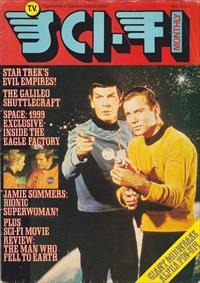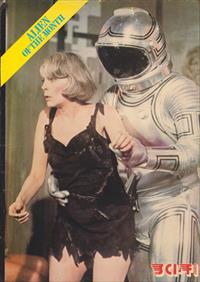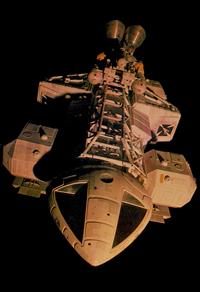TV Sci-Fi Monthly
The centre poster is again Space: 1999, this time a fantastic Eagle/Moonbase art by Gordon C Davies. Davies (1923-1994) was a veteran science fiction artist, doing book covers (including Heinlein and Clarke) as well as centre-spreads for the Eagle comic. There's also an article about the series special effects, and a superb Eagle photo poster.





Space: 1999 is without any shadow of a doubt the most spectacular sci-fi show ever to have been seen on television. Despite flaws in storylines and characterisations in the programme's first series, the show has won overwhelming critical acclaim for its brilliant and breathtaking effects. TV SCI-FI's DON ANDREWS travelled to Britain's Bray Studios to meet the man who built a Moonbase ...
Inside the large. hanger-like studio. a dry ice machine is pumping out acres of fluffy white clouds. On one wall hangs a bright red backdrop - an alien sky many light years from Earth. A complex arrangement of steel pipes stretches out over the 'cloud', two pieces of fishing line disappearing down from it into the swirling mass.
Suddenly there's a shout from the sidelines "Action!" The huge camera, fixed at ground level, begins to whirr. The steel pipes begin to move upwards towards the ceiling. Then, without a sound. a miniature Eagle - no more than two feet in length - breaks from the clouds and soars up towards the arc lights!
The scene is Bray Studios, home of the now-famous Space: 1999 special effects crew and its director, Brian Johnson. Every working day, this pleasant collection of ancient farm buildings set in the English countryside outside London' becomes the setting for a dozen different worlds. It is at Bray that Moonbase Alpha, the Eagles and a stunning assortment of alien spacecraft are designed, constructed and stored. It is here also that all the special light shows, explosions and technical effects are filmed (the 'live' action, using the actual stars, being shot at the nearby Pinewood studio). To walk around Bray Studios is like a trip into the next century!
The man behind all this visual wizardry is Brian Johnson. It is Brian's job to think up designs for spacecraft and moonbases, oversee their construction, and then to direct the film sequences in which they are used.
Brian Johnson is probably one of the best known Special Effects Directors in the world. He began his career as a camera assistant - "sweeping floors, getting coffee" -at Britain's Shepperton Studios in 1958. After a two year spell in the Royal Air Force, he returned to the film industry and worked on a movie called The Day The Earth Caught Fire, all about the sun moving closer to the Earth. "It required shots of London in a drought with aerial shots of the Thames full of cracked mud, no traffic and so on," recalls Brian. "This so fascinated me that I really got the bug for special effects. I used to laugh at other people's special effects, but when I started to do them I realised just what was involved."
From drought-stricken London, Brian moved on to providing the effects for the Hammer horror movies, and then to working on a sci-fi puppet series for television - Thunderbirds - with a gentleman named Gerry Anderson. After 13 episodes of Thunderbirds - a big hit across the country - he was invited by Stanley Kubrick to do effects for the legendary sci-fi epic 2001: A Space Odyssey. With an unlimited budget, Brian and his colleagues created the most visually stunning film ever produced. His speciality was the 'split scan' light effect towards the end of the film which gave audiences the sensation of rushing through psychadelic space. [The split scan was mainly the responsibility of Douglas Trumbull, not Brian Johnson, although they worked closely together on models]
After 2001, Brian worked on several pictures and TV series until, in January 1973. he again teamed up with Gerry Anderson, who had come up with the idea of producing an hour-long 'quality' sci-fi programme to be called Space:1999. However, things were not going well for the show, and by April, plans for Space: 1999 had been cancelled. Britain took off for the West Indies to shoot a movie (The Tamarind Seed) and on his return he found that Gerry Anderson had been given the go-ahead once more for Space:1999, together with a two and a half million pound budget! The project was re-started in August 1973, shooting began in November, and by March 1975 the first series was completed.
One of Brian's first tasks was to construct Moonbase Alpha, an intricate complex of domes, tubes and grey living. quarters which houses Commander Koenig and his castaways on their wild ride through Deep Space. In reality, the Moonbase is only a few feet tall at the most, but so detailed is its construction (moulded from plastic and perspex and using pieces taken at random from plastic construction kits) that it is still an impressive sight up close.
Next came the Eagles, the short range spacecraft that have become something of a Space:1999 trademark in the same way that the USS Enterprise has become one of the most popular 'characters' of Star Trek. The design for the Eagle came, surprisingly enough, from the inhabitants of a world here on Earth ...the insect world!
"I am always trying to make things as believable as possible," explains Brian. "I find that if you make spacecraft, and so on, rather insect-like then you are half way there. That seems to be the way our technology is going. Take Concorde as an example.
"The Eagle was based on a kind of grass-hopper shape which just sort of grew. It was considerably shorter before we started filming, but later it elongated." In a room behind the sound studio there are row upon row of Eagles, ranging from three inches in length up to around four or five feet. All are beautifully constructed from plaster, perspex and moulded copper piping. The largest one, completed with hydraulic landing pads and freon gas propulsion, cost something in the vicinity of £3,000 to produce. In the new series of Space: 1999 the Eagles will be able to be fitted with new booster jet packs for greater flying range.
The most difficult model Brian was required to create for the first series was a mechanical walking device two miles across. To get the thing in perspective required a great deal of time which, when you have only ten days to complete an entire episode of Space: 1999, becomes a problem. In those ten days. Brian and his crew will shoot anything between 35 and 80 shots!
Now, shooting the second Space: 1999 series, it is the 'live' actors and actresses which are causing Brian headaches, rather than his models. In this new batch of episodes, the Moonbase Alpha crew is joined by an alien (Catherine Schell - see last month's TV SCI-FI MONTHLY) who can turn herself into any form of life. Coming up with a constant stream of tigers, bears and spiders for MAYA to transform into is keeping Brian. on his toes. When I visited Bray he had a bizarre collection of Chinese 'hissing beetles' painted with blue spots on his desk, stars of forthcoming episode!
Brian is extremely happy working on the Space: 1999 lot. Whereas he recognises the pioneering excellence of Star Trek, he notes that for him, working on Star Trek would not have been as satisfying. Star Trek producer Gene Roddenberry preferred to rely more on characters and storyline than on special effects. However, Brian would like to work on a Space: 1999 feature film so as to be able to loosen the barriers of time and budget a little. At the moment he's not sure whether Space: 1999 will be transferred to the wide screen.
One project that is in the pipeline, however, is a new series about a family travelling through Space aboard a gigantic spacecraft 'Altares'. Called The Day After Tomorrow, the show tells of the family's voyage from a floating 'satellite world' to Alpha Centauri, and the adventures they encounter on their journey including getting caught in a Black Hole. The series is set in the mid-21st century, so the technology will be much more advanced than that used by Moonbase Alpha. For instance, the Altares is a Deep Space vehicle driven by a Photon Drive which can accelerate the ship to near the speed of light. The reason why a family is used is that. although by Earth time they will have been gone only 21/2 years on the voyage, by their time they will have journeyed something like 35 years! A family seemed like the best unit to survive the trip.
A pilot episode has already been shot of the series, using Brian's amazing Altares (which is now stored in a huge crate alongside Moonbase Alpha at Bray Studios). The BBC in Britain has snapped up the rights to the show and in the USA. NBC is considering it at this very moment.
Let's all hope that it gets a very speedy go ahead. If it means more of Brian Johnson's incredible talents being displayed, then it should be an astronomical success!